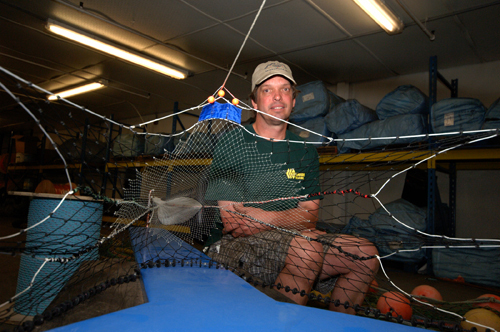
An Ocean State net designer has joined with Rhode Island Sea Grant scientists and three Rhode Island fishermen in developing a net that catches haddock but not cod or flounder.
Dubbed the Eliminator Trawl, the net won a $30,000 award from the World Wildlife Fund (READ MORE) Now net supporters are waiting for the National Marine Fisheries Service (NMFS) to clear the Eliminator for a Special Access Program (SAP), which would allow fishermen into currently closed areas to target large schools of recovered haddock.
The closed areas cover huge sections of Georges Bank and the Nantucket Shoals. They were closed in the 1990s to help protect spawning cod, flounder and haddock. Haddock are now considered recovered, while cod and flounder are still rebuilding.
“The net should be approved for an SAP,” said Jon Knight, owner of Superior Trawl in Narragansett and the maker of the Eliminator Trawl. “But then you’ll have to get the SAP permit. This permit will give boats access into the closed areas.”
Knight’s company makes and designs innovative types of fishing gear.
He is interested in ways to reduce bycatch – non-target species – while increasing catching efficiency of the target species. Species-selective fishing gear is becoming a very important tool in bycatch reduction.
“The Eliminator is not really new net. We designed it in the ’90s to be a squid net. We knew it would catch squid and it did,” Knight said. “And then along came all the haddock and the net caught them too. But it didn’t catch cod very well or flounder. This interested us and we went back to the design board and did a little tweaking.”
The net was developed with the help of Rhode Island fishermen Phil Ruhle Sr., his son Phil Ruhle Jr., and Jim O’Grady.
The Eliminator Trawl has giant meshes in the mouth and wings of the net that are 8-feet long. The net then tapers back, dropping down in mesh size, all the way to 6.5 inches in the cod-end.
Cod, haddock and flounder all behave differently when they encounter a net. Cod go straight down and so do flounder. The Eliminator has a kite which lifts the top of the net high into the water, pulling the meshes away from the bottom. But the weight of the sweep – the part of the net in contact with the sea floor – keeps the net from lifting completely off the bottom. The kite pulls and the sweep resists. But the big 8-foot meshes give the cod and flounder a kind of wide-open escape panel; they simply swim down and out.
And the haddock, instead of swimming down, swim up and run into smaller meshes, getting caught.
“The Eliminator Trawl is a great net,” said Joel Hovanesian, a Point Judith fisherman. “I have one and would love to be able to go into the closed areas and catch haddock and not burn up my other groundfish days.”
Groundfish boats are only given about 44 days a year to fish. A fisherman can lease days if he wants to, basically buying opportunity to fish. These 44 days are called A-days. The Eliminator Trawl would be considered a B-day use, which wouldn’t use up the fisherman’s A-days. “So if the Eliminator Trawl is accepted, then we’d be able to fish more days per year,” says Hovanesian. “And there’s nothing wrong with that.”
“I think we are very close to a B-day decision with the Eliminator Trawl,” says Dave Beutel, a fishery extension specialist with the Rhode Island Sea Grant, located at the University of Rhode Island. “Then people will be able to apply pressure to get approval for an SAP.”
Due to a number of strong classes of haddock, the NMFS has allowed each boat to catch an unlimited amount of haddock per trip. All other species of groundfish have a trip limit. For example, a boat is allowed to catch 1,000 pounds of codfish per day. So a six-day trip would equal 6,000 pounds.
Yet, the New England fleet is only catching 3 percent of what they are allowed to catch for haddock. So where are all the haddock?
“A lot of haddock are inside the closed areas. We can’t go in and fish for them,” explained Hovanesian.
The idea of the Eliminator has been proven: 100 side-by-side comparison tows were conducted on Georges Bank in 2007, one boat towing the Eliminator, the other boat towing a regular groundfish net, and the data showed that the Eliminator Trawl reduced bycatch of cod by 84 percent and flounder by 90 percent.
Still, “we need to be smart about how we do this,” Hovanesian said.
If SAP approval is granted, “we need to be very careful in how we let boats into the closed area. I wouldn’t want to see 300 boats inside a closed area, all landing big trips of haddock. The market would become saturated.” •












